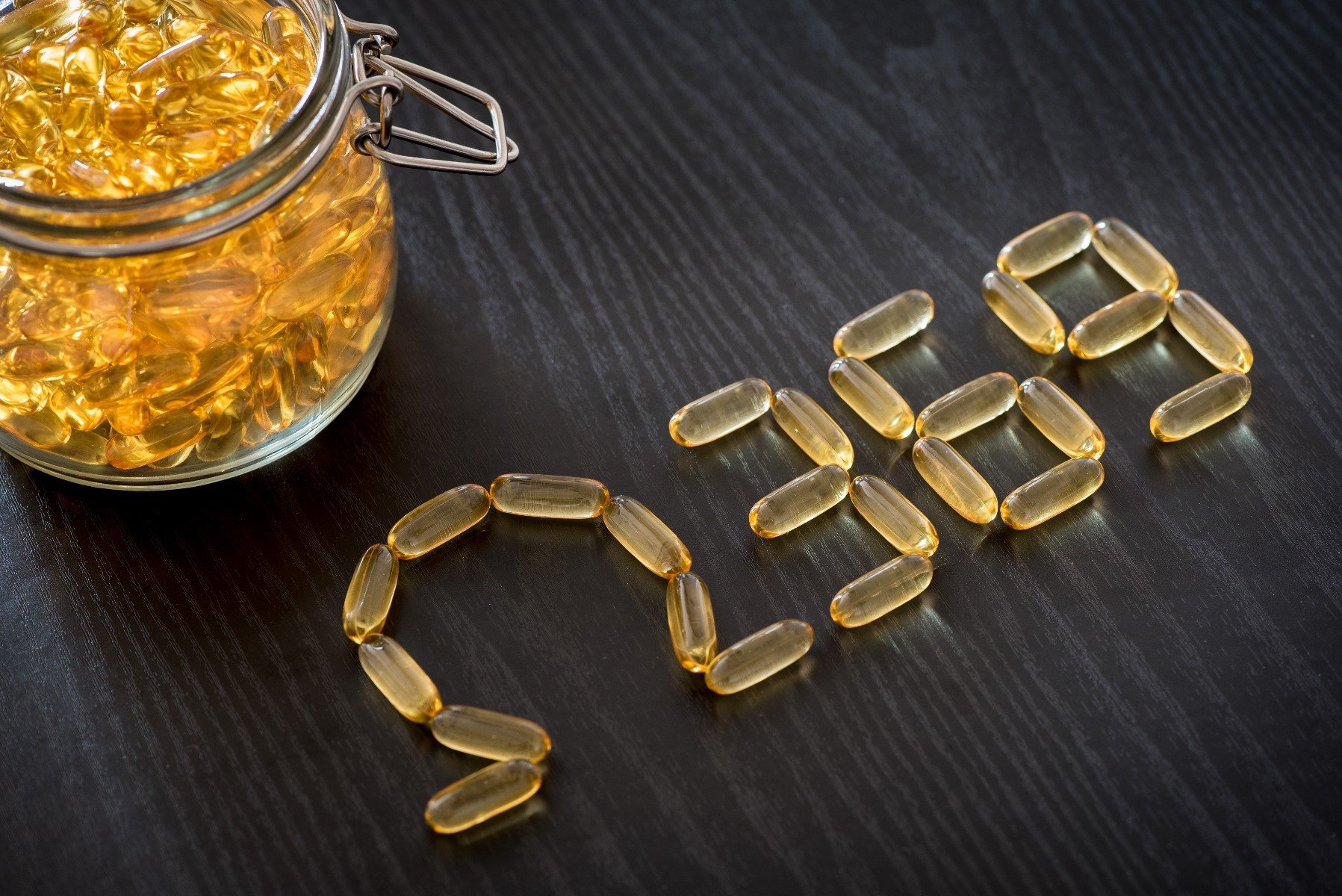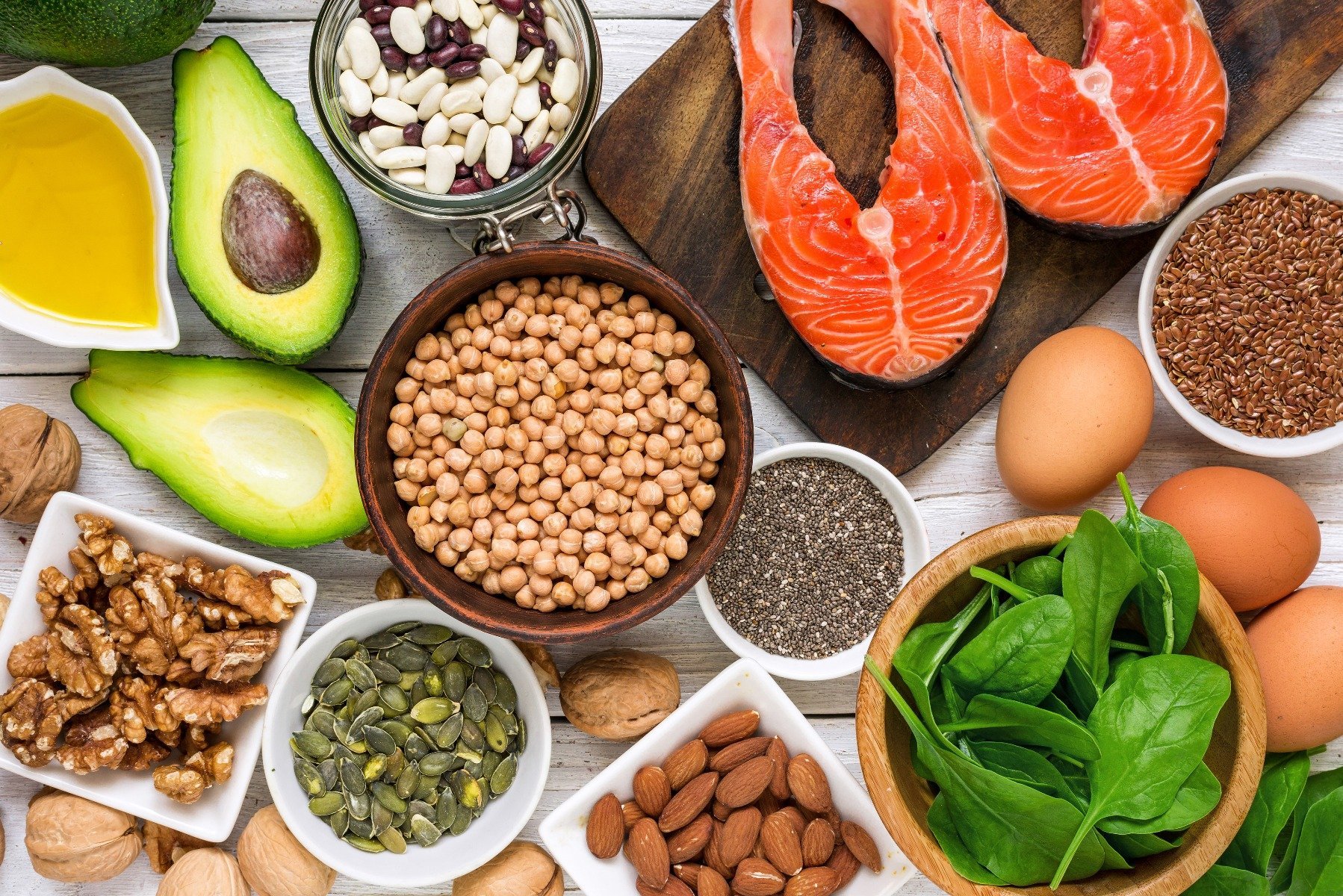Table of Contents
To start to analyze the effects and importance of taking omega-3 and omega-6 fatty acids, we need to explain their nature in the body first. They are part of the fatty acids and thus of the healthy fats that our body uses for various tasks. Read the article to learn how we divide omega fatty acids, what are their effects and when they need to be supplemented.
What are fatty acids?
These are the main components of fat that we classify into two groups – non-essential fatty acids, which the human body can create itself, and essential fatty acids, which we need to take in the diet or supplements because the body can only store them and can not create them. [1] Essential fatty acids are somewhat similar to vitamins because we need to supplement them from external sources. However, we need to take fatty acids in much higher proportions than vitamins.

Types of omega fatty acids
Fatty acids are also divided into saturated and unsaturated. The term “saturated” fatty acids refers to the absence of a double carbon bond in the acid chain. These include palmitic and stearic acids. Their increased intake causes obesity and increased bad cholesterol resulting in cardiovascular disease.
Unsaturated fatty acids contain a double carbon bond. Either one – monounsaturated (oleic acid) or multiple carbon double bonds. At that time we are talking about polyunsaturated acids (linoleic acid, α-linolenic acid ALA, arachidonic AA, eicosapentaenoic EPA acid, docosahexaenoic DHA acid). [3] The distribution of molecules in space remembers either a chair, when we talk about the trans-form or the bath, the cis-form.
The division of these acids into omega-3-6-9 depends on the location of the first double carbon bond in the chain. It is located on either the third, sixth or ninth carbon atoms. We talk about this because different acid structures significantly affect their effects on human health. Each from omega acids has different advantages and comes from different source. [1]

You might be interested in these products:
How are omega fatty acids formed?
Biologically most important for the human body are omega-3 and omega-6 acids. [2] Omega-3 includes α-linolenic acid ALA, eicosapentaenoic EPA and docosahexaenoic DHA. The category omega-6 fatty acids include linoleic acid LA, arachidonic acid AA and γ-linolenic acid GLA. [3]
The human body is capable of producing only omega-9 fatty acids by itself. Omega-3 and omega-6 can only be taken in the form of diet or supplements. The body can not synthesize itself the acids LA and ALA, but from them it can further create EPA, DHA and AA. [2] It is important to orientate in this breakdown since we take each acid from different sources of nutrition, but only by combining all of them we can ensure a sufficient level of omega-3 fatty acids.

Differences between omega-3 omega-6 and omega-9
As we have already mentioned above, from a chemical point of view, there is a difference between these acids in the composition of the molecule and in the order of the double carbon bond, which is either in the 3rd, 6th or 9th place in the chain. Other differences include:
1. Different formation of omega fatty acids in the body
There is also a difference in their synthesis. While the body can produce omega-9 by itself, we should take omega-3 and omega-6 in the diet or in the form of nutritional supplements.
2. Other sources of omega-3-6-9 in diet
The essential source of omega-9 is olive oil. Other sources include oilseed rape, goose liver, coconut, soy and almond oil. [7] Omega-9 is consumed the most common, yet it is important to take it in a targeted way – by balanced diet and nutritional supplements.
The ideal ratio of omega-6 and omega-3 fatty acids is 4: 1 according to the specialists. [4] Omega-6 acids are found in corn, sunflower and grape seeds, in pumpkin and flax seeds, in soy or peanuts. [8] It is also included in vegetable oils, walnuts and pine nuts. [9]
The biggest source of omega-3 is fish meat, mainly from seafood such as salmon, mackerel, tuna, herring or sardines. Among the freshwater there are: trout, carp, eel, pelvis, grayling and catfish. [4] Other sources include walnuts, flax and chia seeds and vegetable oils – flax, soy and rapeseed oil.
Currently, producers also add omega-3 to so-called enriched foods. These include some brands of eggs, yoghurts, juices, milk, soy drinks and baby food. [10] With natural sources of omega-3 it is important to note that eating only plant omega-3 is not sufficient because you only get ALA acids from them. EPA and DHA can be supplemented with fish or supplements.

3. Diverse health effects of omega fatty acids
Different omega also have different effects on health. Omega-9 is beneficial for lowering the level of “bad” LDL cholesterol and also has an anti-inflammatory effect. [4] Omega-6 can help in rheumatism, breast cancer and it is part of a weight loss diets as it helps to reduce weight. [5] [6] It is also an excellent prevention of diabetes.
The benefits of taking omega-3 are many, and these essential acids are an unmistakable essence of human health and well-being.

15 advantages of taking omega-3 fatty acids
Read 15 most important effect of omega-3 fatty acids on our body, health and brain.
1. They fight with depression and anxiety
Depression is today the most common mental disorder of adults and adolescents. It appears as sadness, lethargy, unwillingness to live, anxiety and nervousness. Studies show that people who regularly consume omega-3 are less likely to get depressed. [11]
On contrary, omega-3 help people suffering from this disease to alleviate symptoms. In fight with mental disorders, it is recommended to increase the intake of EPA acid. One study even found out that EPA can be as effective as antidepressants. [13]

2. They improve eye health and vision
DHA acid is the major component of the retina of the eye (up to 60%) and its deficiency is showed by impaired vision. Regular consumption of omega-3 goes hand in hand with a reduced risk of ocular mascular degeneration, a disease that is the most common cause of blindness and permanent eye damage. [13]
3. They support healthy development of the child during pregnancy and early childhood
Taking omega-3 fatty acids during pregnancy is beneficial not only for the mother but especially for the baby. It is also one of the few supplements that it is strongly recommended to take during pregnancy. This is for the benefits of – higher child´s intelligence, better communication skills, fewer behavioral problems, reduced risk of ADHD, autism and cerebral palsy. [15] DHA deficiency can also cause premature birth and some deaths at birth. [1]
Breast milk itself largely composed of DHA. It is the same form of DHA that can be found in fish fat, so breastfeeding is important for the child’s development and immunity for the future. [1] Children who were feeding with an omega-3-rich diet tend to have better vision and a less predisposition to hyperactivity. [16]

4. They are excellent prevention of cardiovascular diseases
Omega-3 lower the blood pressure, reduce triglycerides, increase levels of “good” HDL cholesterol, prevent the formation of blood clots. They keep the arteries firm and elastic, prevent arterial hardening known as plaque. All these factors greatly reduce the risk of heart disease. [17] [18] [19] [20]
5. They reduce symptoms of metabolic syndrome
Metabolic syndrome is a series of symptoms that lead to health problems. They include obesity, high blood pressure, insulin resistance, elevated triglycerides and low HDL cholesterol. Omega-3 effectively improve these symptoms, thereby improving the course of the disease. [21]
6. They help against inflammation and autoimmune diseases
Inflammation is a natural reaction, our body’s response to infections or injuries. However, it sometimes takes too long or persists for no reason. In this case, we are talking about chronic inflammation that can cause a variety of diseases, including cancer. [22] Studies have concluded that higher omega-3 intake helps to reduce inflammation. This is because omega-3 acids reduce the production of molecules and substances associated with inflammation, the so-called eicosanoids and cytokines. [23]

7. They improve autoimmune diseases
Studies have confirmed that taking omega-3 in the child’s first year reduces the development of autoimmune diseases such as diabetes and multiple sclerosis. [24] Supplements omega-3 also treat the symptoms of lupus, rheumatoid arthritis, Crohn’s disease and psoriasis. [4] Although they do not cure these diseases, they significantly affect their external reflections.
8. They improve the process of mental disorders
Low levels of omega-3 fatty acids have been measured in people with psychiatric disorders. [26] Fatty acid supplementation affects the frequency of violent and hyperactive behavior in children and adults. [25]
9. They can help to prevent the formation of cancer
Omega-3 can reduce the risk of breast and prostate cancer,[28] and can prevent colon cancer by up to 55%. [27]

10. They have a positive effects on bones and joints
Osteoporosis and arthritis are diseases that most of the population is worried about. It is the intake of omega-3 fatty acids that can boost calcium production, thus strengthening the bones. At the same time, omega-3 acids treat arthritis and are effective against joint pain. [29]
11. They relieve menstrual pain
The study says that regular supplementation of omega-3 fatty acids is more effective than ibuprofen in the treatment of severe menstrual lower abdominal pain. [30]
12. They improve sleep quality and help with insomnia
Good sleep is the key to good health and a good mood. The lack of omega-3 that causes insomnia and low levels of melatonin – a hormone that helps us to fall asleep. Studies in adults and children have shown that intake of omega-3 fatty acids affects sleep quality and its duration. [31]

13. They maintain the healthy skin
DHA is a part of the skin and therefore it strongly affects its elasticity, softness and hydration. EPA, on the other hand, works to alleviate premature aging and reduces acne. [33] Omega-3 also help to protect the skin from sunlight. [32]
14. They are effective against stress
Fish oil supplementation has been studied in rats exposed to pneumonia as a factor of environmental stress. Omega-3 supplementation normalized their response to induced stress. [35] This research was later mimicked in other animals as well as in humans where studies confirmed that high daily intake of DHA weakened the adrenaline response to a stressful situation. [36]
In terms of stress, the effects of both EPA and DHA can be very beneficial. EPA affects immune function in stressful situations and DHA levels rise sharply during stress. [37] [38] Interesting fact is that the dose of EPA and DHA can reduce norepinephrine even in people who are not exposed to a stressful situation. [39]
15. They support memory and learning
DHA also plays a role in memory formation. Higher concentration of DHA is associated with better verbal skills, especially in the elderly. [41] Studies in rats have confirmed that DHA deficiency may cause memory problems. Studies on animals have also shown that consumption of DHA can positively affect long-term memory in otherwise healthy rats. [42]
Research in healthy young people aged 18-25 years has seen improvement in working memory after 6 months of taking 750 g DHA and 930 g EPA. This is especially necessary when performing various work activities as it combines knowledge of short and long term memory. [43]

Omega-3 and sports performance
Supplement omega-3 is associated with delayed and alleviated onset of muscle pain after muscle damage during training. In the football group after supplementation of omega-3, an increase in anaerobic endurance capacity was found out compared to the placebo group. In addition, the increase in nitric oxide production was associated with higher absorption of muscle oxygen. VO2 max, so the maximum oxygen consumption, has been proven in a group of endurance cyclists who have used omega-3.
Also list of benefits is a proof that omega-3 fatty acids are very necessary and useful for health. Therefore, they should not be forgotten and should be supplemented through balanced nutrition or quality supplements. [40]
Symptoms of deficiency of omega-3 fatty acids
If you suffer from unexplained tiredness or constipation for a long time, your skin is dry, your nails and hair break, you are often cold, you have depression and joint pain – you may be missing omega-3 fatty acids. [1] Do you not agree? Do you eat fish and vegetable oils? Maybe not enough. According to experts, we should consume fish 2 times a week to ensure the established standard of omega-3 fatty acids.
The latest European survey Eurobarometer examined the amount of fish consumption in the European Union. Statistics showed that only 18% of Slovaks consume fish at least once a week, while the European average is 42%. [34] Risk groups are mainly children, pregnant and breastfeeding women, seniors or vegans. [4]
If you belong to the people who do not like fish, are allergic to them, or simply can not feel them at all, choose from a number of dietary supplements which we also offer on our eshop.

Supplements of omega-3 fatty acids
Well-knows fish oil is ideal dietary supplement for those of us who do not like fish or who do not consume it twice a week for any other reasons. We can supplement omega-3 also with oil from goose liver or from seaweed. At us most often you buy omega-3 in capsules or in a combination omega-3-6-9 fatty acids. Supplements can also be found in liquid form, but most consumers prefer the form of capsules because they are tasteless. Suitable alternative is also flavored fish oil, the aroma and taste of which are enhanced by stevie and enriched with vitamins.
Recommended dosage of omega-3 fatty acids
The recommended amount of ALA acid was determined by experts based on age, sex and life stage. Check the table below for the exact dosage. [10]
| Baby up to 12 months | 0,5 g |
| Child 1-3 years | 0,7 g |
| Child 4-8 years | 0,9 g |
| Boys 9-13 years | 1,2 g |
| Girls 9-13 years | 1,0 g |
| Boys 14-18 years | 1,6 g |
| Girls 14-18 years | 1,1 g |
| Men | 1,6 g |
| Women | 1,1 g |
| Pregnant women | 1,4 g |
| Breastfeeding women | 1,3 g |
The recommended doses of EPA and DHA have not been clearly established, but sources suggest a daily dose of at least 250 mg EPA and 250 mg DHA. To enhance the effects of omega fatty acids, we recommend combining the supplements with vitamin B. I think that after reading this article, each of us decides to go for omega fatty acids. They have a unique health effect on our body. And to be honest, who does not need to stimulate the brain today, drive off fatigue and boost the performance?
And what about you? Do you eat fish twice a week or do you supplement omega-3 in form of supplements? Let us know in comments. And do not forget to share this article if you like it and you found facts you did not know about.
[1] Pavel Blažíček - Prečo sú pre zdravie nevyhnutné omega-3 mastné kyseliny – https://www.alphamedical.sk/casopis-invitro/preco-su-pre-zdravie-nevyhnutne-omega-3-mastne-kyseliny
[2] Eva Janíková - Využitie omega-3 nenasýtených mastých kyselín u onkologických pacientov – https://is.muni.cz/th/nkxm1/Vyuzitie__-3_nenasytenych_mastnych_kyselin_u_onkologickych_pacientov.pdf
[3] Veronika Hrušovská - Omega-3 nenasycené mastné kyseliny ve výživě – https://is.cuni.cz/webapps/zzp/detail/155634/
[4] Ruairi Robertson - Omega-3-6-9 Fatty Acids: A Complete Overview – https://www.healthline.com/nutrition/omega-3-6-9-overview#section3
[5] Stacie K. Totsch, Robert E. Sorge - Progress in Molecular Biology and Translational Science - Omega-3 and Omega-6 PUFAs – https://www.sciencedirect.com/topics/agricultural-and-biological-sciences/omega-6-fatty-acid
[6] Whigham LD, Watras AC, Schoeller DA - Efficacy of conjugated linoleic acid for reducing fat mass: a meta-analysis in humans. – https://www.ncbi.nlm.nih.gov/pubmed/17490954
[7] Omega-9 Fatty Acids (Oleic Acid) – http://orthomolecular.org/nutrients/omega9.html
[8] Arthritis Foundation - 8 Food Ingredients That Can Cause Inflammation – https://www.arthritis.org/living-with-arthritis/arthritis-diet/foods-to-avoid-limit/food-ingredients-and-inflammation-5.php
[9] Moira Lawler - How Foods Wuth Omega-6 Fatty Acids May Help Prevent Type 2 Diabetes – https://www.everydayhealth.com/type-2-diabetes/diet/omega-fatty-acid-foods-help-prevent-diabetes/
[10] Omega-2 Fatty Acids – https://ods.od.nih.gov/factsheets/Omega3FattyAcids-Consumer/
[11] J. Clin Psychiatry - A meta-analytic review of double-blind, placebo-controlled trials of antidepressant efficacy of omeha-3 fatty acids. – https://www.ncbi.nlm.nih.gov/pubmed/17685742
[12] Kiecolt-Glaser JK, Belury MA, Andridge R, Malarkey WB, Glaser R. - Omega-3 supplementation lowers inflammation and anxiety in medical students: a randomizes controlled trial. – https://www.ncbi.nlm.nih.gov/pubmed/21784145
[13] Shima Jazayeri, Mehdi Tehrani Doost, Seyes A Keshavarz, Mostafa Hosseini, Abolghassem Djyzayery, Homayoun Amni - Comparison of therapeutic effects of omega-3 fatty acid eicosapentaenoic acid and fluoxetine, separately and in combination, in major depressive disorder – http://www.tandfonline.com/doi/abs/10.1080/00048670701827275
[14] Lim Ls, Mitchell P, Seddon JM, Holz FG, Wong TY - Age-related macular degeneration – https://www.ncbi.nlm.nih.gov/pubmed/22559899/
[15] Strickland AD - Prevention of cerebral palsy, autism spectrum disorder, and attention deficit-hyperactivity disorder. – https://www.ncbi.nlm.nih.gov/pubmed/24581674
[16] Tai EK, Wang XB, Chen ZY - An Update on adding docosahexaenoic aic (DHA) and arachidonic (AA) to baby formula – https://www.ncbi.nlm.nih.gov/pubmed/24150114
[17] Oliveira JM, Rondó PH - Omega-3 fatty acids and hypertriglyceridemia in HIV-infected subjects on antiretroviral therapy: systematic review and meta-analysis. – https://www.ncbi.nlm.nih.gov/pubmed/22180524
[18] Ramel Al, Martinez JA, Kiely M, Bandarra NM, Thorsdottir I - Moderate consumption of fatty fish reduces diastolic blood presure in overweight and obese European young adults during energy restriction. – https://www.ncbi.nlm.nih.gov/pubmed/19487105
[19] Berstein AM, Ding EL, Willett WC, Rimm EB - A meta-analysis shows that docosahexaenoic acid from oil reduces serum triglycerides and increase HDL-cholesterol and LDL-cholesterol in persons without coronary heart disease. – https://www.ncbi.nlm.nih.gov/pubmed/22113870
[20] Miyoshi T, Noda Y, Ohno Y, Sugiyama H, Oe H, Nakamura K, Kohno K, Ito H - Omega-3 fatty acids improve postprandial lipenia and associated endothelial dysfuction in healthy individuals - a randomizes cross-over trial. – https://www.ncbi.nlm.nih.gov/pubmed/25458786
[21] Robinson LE, Mazurak VC - N-3 polyunsaturated fatty acids: relationship to inflammation in healthy adults and adults exhibiting features of metabolic syndrome. – https://www.ncbi.nlm.nih.gov/pubmed/23456976
[22] Coussens LM, Werb Z. - Inflammation and cancer. – https://www.ncbi.nlm.nih.gov/pubmed/12490959
[23] Simopoulos AP - Omega-3 fatty acids in inflammation and autoimmune diseases. – https://www.ncbi.nlm.nih.gov/pubmed/12480795
[24] Stene LC, Joner G, Norwegian Childhood Diabetes Study Group - Use of cold liver oil during the first year of life is associated with lower risk of childhood-onset type 1-diabetes: a large, population-based, case-control study. – https://www.ncbi.nlm.nih.gov/pubmed/14668274
[25] Benton D. - The impact of diet on anti-social, violent and criminal behaviour. – https://www.ncbi.nlm.nih.gov/pubmed/17433442
[26] Giuseppe Grosso, Fabio Galvano, Stefano Marventano, Michele Malaguarnera, Clauidio Bucolo, Filippo Drago, Filippo Caraci - Omega-3 Fatty Acids and Depression: Scientific Evidence and Biological Mechanisms – https://www.ncbi.nlm.nih.gov/pmc/articles/PMC3976923/
[27] Theodaratou E, McNeill G, Cetnarskyj R, Farrington SM, Tenesa A, Barnetson R, Porteous M, Dunlop M, Campbell H. - Dietary fatty acids and colorectal cancer: a case-control study. – https://www.ncbi.nlm.nih.gov/pubmed/17493949
[28] Terry PD, Terry JB, Rohan TE - Long-chain (n-3) fatty acid intake and risk of cancers of breast and the prostate: recent epidemiological studies biological mechanisms, and directions for future research. – https://www.ncbi.nlm.nih.gov/pubmed/15570047/
[29] Kruger MC, Horrobin DF - Calcium metabolism, osteoporosis and essential fatty acids: a review. – https://www.ncbi.nlm.nih.gov/pubmed/9624425
[30] Mandala Zafari, Fereshteh Behmanensh, Azar Agha Mohammadi - Comparison of the effect of fish oil and ibuprofen on treatment of severe pain in primary dysmenorrhea – https://www.ncbi.nlm.nih.gov/pmc/articles/PMC3770499/
[31] Anita L. Hansen, Lisbeth Dahl, Gina Olson, David Thorton, Ingvild E. Graff, Livar Froyland, Julian F. Thayer, Staale Pallesen - Fish Consumption, Sleep, Daily Functioning, and Heart Variability – https://www.ncbi.nlm.nih.gov/pmc/articles/PMC4013386/
[32] Meagen M. McCasker, Jane M. Grant-Kels - Healing fats of the skin: structural and immunologic roles of the omega-6 and omega-3 fatty acids – https://www.sciencedirect.com/science/article/pii/S0738081X10000441
[33] Spencer EH, Ferdowsian HR, Barnard ND - Diet and acne: a review of the evidence. – https://www.ncbi.nlm.nih.gov/pubmed/19335417
[34] Koľko rýb a morských plodov zjedia Slováci – https://ec.europa.eu/slovakia/news/EU_consumer_habits_regarding_fishery_sk
[35] Eguchi R, et al. - Fisch oil consumption prevents glucose intolerance and hypercorticosteronemy in footshock-stressed rats. – https://www.ncbi.nlm.nih.gov/pubmed/21569357
[36] Hamazaki T, Sawazaki S, Nagasawa T, Nagao Y, Kanagawa Y, Yazawa K - Administration of docosahexaenoic acid influences behavior and plasma catecholamine levels at times of psychological stress. – https://www.ncbi.nlm.nih.gov/pubmed/10419086
[37] Song C, Li X, Leonard BE, Horrobin DF - Effects of dietary n-3 or n-6 fatty acids on interleukin-1beta-induces anxiety, stress, and inflammatory responses in rats. – https://www.ncbi.nlm.nih.gov/pubmed/12837849
[38] Takeuchi T, Iwanaga M, Harada E - Possible regulatory mechanism of DHA-induces anti-stress reaction in rats – https://www.ncbi.nlm.nih.gov/pubmed/12573522
[39] Hamazaki K, Itomura M, Huan M, Nishizawa H, Sawazaki S, Tanouchi M, Watanabe S, Hamazaki T, Terawśawa K, Yazawa K - Effect of omega-3 fatty acid-containing phospholipids on blood catecholamine concentrations in healthy volunteers: a randomized, placebo-controlled, double-blind trial. – https://www.ncbi.nlm.nih.gov/pubmed/15925295
[40] Ben Samuels - The science behind omega 3s – https://www.scienceinsport.com/sports-nutrition/the-science-behind-omega-3s/
[41] Matthew F. Muldoon, Christopher M. Ryan, Lei Sheu, Jeffrey K. Yao, Sarah M. Conklin, Steephen B. Manuck - Serum Phospholipid Docosahexaenonic Acid Is Associated with Cognitive Functioning during Middle Adulthood – http://jn.nutrition.org/content/early/2010/02/24/jn.109.119578.abstract
[42] Gamoh S, Hashimoto M, Sugioka K, Shahdat Hossain M, Hata N, Misawa Y, Marumura S - Chronic administration of docosahexaenoic acid improves reference memory-related learning ability in young rats. – https://www.ncbi.nlm.nih.gov/pubmed/10430487
[43] Rajesh Narendran, William G. Frankle, Neale S. Mason, Matthew F. Muldoon, Bita Moghaddam - Improved Working Memory but No Effect on Striatal Vesicular Monoamine Transporter Type 2 after Omega-3 Polyunsaturated Fatty Acid Supplementation – https://journals.plos.org/plosone/article?id=10.1371/journal.pone.0046832

